General Metal and Holloware
 |
Orme Evans & Co. Ltd.
Elgin Works, Great Brickkiln Street |
 |
The 1927 Catalogue
The illustrations on this page and the next are taken
from the company's, dated May 1927. It is redolent of its
age, still largely Victorian and quite different in many respects from
the world that was ushered in by the Second World War. Most of
Orme Evans' products in this catalogue were for domestic use, though
they also have a large section on "Dairy Accessories". This
catalogue enables us to wander through many of the rooms of a household
of the 1920s.
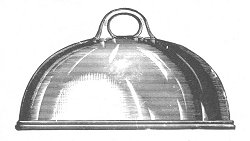 |
Ormes offered several shapes of Dish Covers,
available either in block tin or aluminium. They would not
have been uncommon in middle class homes but, of course, much
commoner, in silver or EPNS, in the upper classes. To-day
we only see them in the catering trade. |
| This is a muffin dish, an item not much in use
to-day. The dish is hollow and the cap at the front lifts
off, enabling you (well, your cook) to fill it with hot water,
to keep the muffins warm. This dish has an earthenware
liner but there can be little doubt that part would not have
been made in Wolverhampton. |
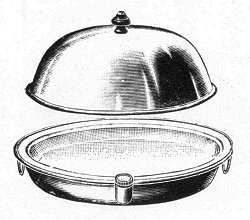 |
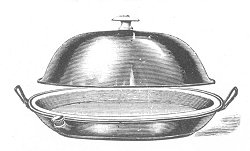 |
This is a hot water breakfast dish, also with an
earthenware liner. In higher class households breakfast
was not at a set time and people were expected to come down when
it suited them. So some way of keeping the various dishes
hot was needed. |
| You could keep things hot with a breakfast heater,
which had a spirit lamp underneath it. This seems to be
identical to the item produced by Henry Loveridge & Co - which
went out of business in 1927. Perhaps Orme Evans bought up
their designs, or remaining stock - or just copied. |
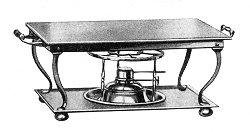 |
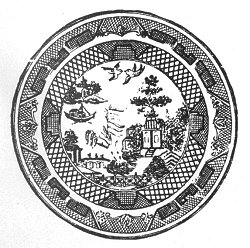 |
Orme's also offered a hot water steak dish and a
hot water bacon dish, as well as seven different designs of hot
water plates. Hot water plates are usually associated with
feeding children or invalids. The one exhibited here is in
the all too familiar willow pattern. |
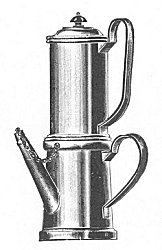 |
Orme's also offered a coffee pot and two sorts of
cafetiere and a tea and coffee urn, for really large households
or for mass catering. They also had milk saucepans, a
kitchener (a hot water boiler), fish kettles and fish slices. Still in the kitchen, they have oven pans, baking pans, gravy
strainers, colanders, egg poachers, 4 kettles, each available in
several sizes and not one of them electric. |
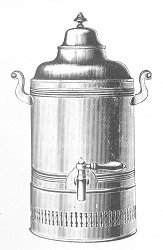 |
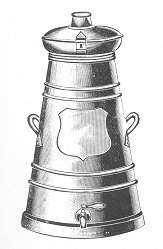 |
Amongst their dairy utensils and appliances there
are milking pails, several milk strainers, cream skimmers,
several types of "railway and lorry milk cans, designed to
resist rough transportation", a plain delivery can, and this
delivery can on the left with a tap. Presumably the
dairyman used the tap to put the milk in your own jug, but more
usually he would dip in with a government stamped measure
(right) and put it from there. These measures came in 1/4,
1/2, 1 and 2 pint sizes. |
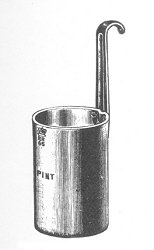 |
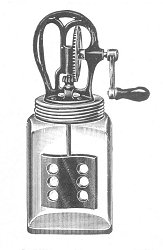 |
Many households, small and large, would have made their own
butter. This is a three pint size. Fruit bottling was still popular but Orme's may have been
feeling the pressure of tinned goods when, having declared
themselves to be "pioneers of domestic fruit bottling and
largest distributors", they say that this is the only way to
keep fruit and vegetables for winter use and "all other methods
are substitutes". |
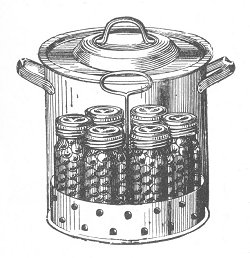 |
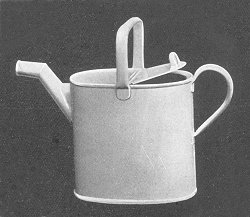 |
After an icing syringe, with 42 patterns of icing
tubes available to go with them, and the Never Burn round cake
tin, we get to the more prosaic matter of hot water. These
cans are available in several sizes, japanned in various colours
or in an oak grain effect, or, like this one, finished in white
cellulose. This is the only item in the catalogue which
gets a black background and a cellulose finish. The design
is practically identical to that of water cans produced in brass
and copper by many makers.
When piping water round the house was uncommon, these cans
would have been vital for bringing hot water from the kitchen to
the bathroom or bedroom. |
| And you (or the maid - most middle class
households would have had at least one "daily woman") also had
to bring in the coal, in the days before central heating,
electric heating and the like. This anthracite "server"
would have done the job.
The coal would be in the cellar
on in the coal hole at the side of the house. Using the
two handles, you shoved this thing, nose first, into the heap,
repeating the action until it was full, and then brought it in.
(A lot of people called this object a coal hod).
This
server is japanned black with brass or copper bands and probably
looked quite respectable. You might therefore have left it
in the grate, next to the fire. |
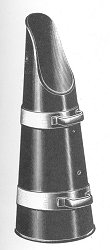 |
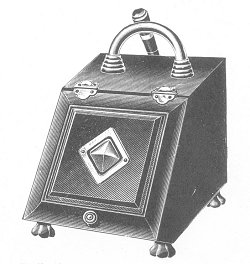 |
Or you might simply have tipped the whole load
into something more decorative such as this coal box.
Ormes provided quite a selection of these and also a good
selection of coal buckets and cauldrons, like the Wellington
below, which all served the same purpose. You would choose
one which you fondly thought matched the decor of your home.
Since fires would be lit, in homes which could afford the coal,
in the kitchen, at least one reception room and one or more
bedrooms, you might need more than one box, bucket or cauldron. |
| It might be worth mentioning here, for the benefit
of our younger visitors, that whatever people now think of the
visual effect of a coal fire, they caused an awful lot of work,
lighting them, dragging the coal in, keeping them stoked up,
then clearing them out and throwing away the ashes; and
they caused so much soot and dust that a room with a fireplace
had to be cleaned thoroughly every day. Worse, they were
not very efficient at heating the room. Next to the fire
you might burn; over by the door you might freeze. |
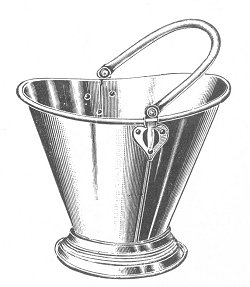 |
 |
If you were using large lumps of coal you had to
get them from the coal box to the fire, without getting your
hands too dirty. These coal tongs or, as Ormes called
them, "The Perfect Coal Scissors", were supposed to help. |
|

|
|
Proceed to the
next page |
|


















